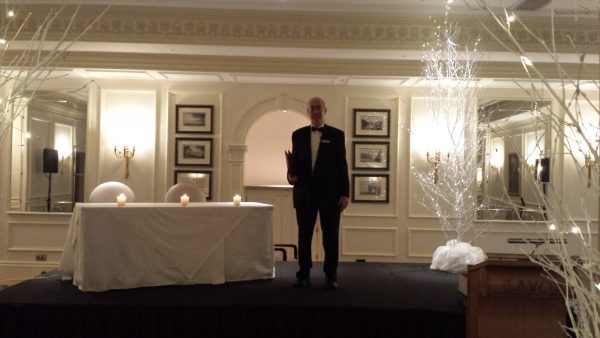
by Michael | Feb 6, 2018 | Blog
Of course, wedding mishaps never happen … And just who am I trying to kid?!
Whether a professional wedding planner is employed, or whether you’re doing it ‘in-house’, there is plenty of scope for disaster. You simply cannot legislate for everything. Especially children, animals or the weather.
You can prepare all you like, but the one thing you haven’t prepared for will probably occur.
Of course, the key is how to deal with the circumstance. And ignoring it, throwing a tantrum or blaming other people really won’t cut it. It’s calm, decisive action that saves the day.
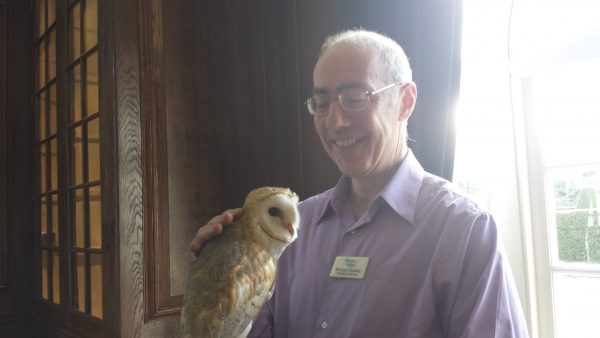
Should you work with children or animals?
A few mishaps
In my five years officiating weddings and the like, I have, fortunately, not had to deal with situations that were too desperate.
Brain melt-down
At my first wedding, the groom totally forgot the rings! (Inexperienced as I was, I assumed that he would never forget the only thing he needed to bring with him!) When I jokingly asked him about it half an hour before the ceremony started, he went very pale! It was back to the hotel for him (nearby, luckily), and he returned before the bride even came in. (Just!)
Fire
There was a fire in the kitchen of a venue that delayed the start of the ceremony for three quarters of an hour. No point in panicking – there was a nearby (scenic) lake, so I started discussing with the venue planner whether we could move a few chairs across and hold the ceremony there (especially as the weather was beautiful).
As it happened, the fire was extinguished in time for us to return to the interior peacefully.
Last minute change
I did not expect any hitches when I rocked up to conduct a wedding at the Savoy Hotel (photo above) in front of 200 guests. We had had a successful rehearsal a few days previously, and there was a highly competent wedding planner in charge.
What could possibly go wrong?
Apart from a delayed start due to a number of late arrivals, all seemed to be going very smoothly. Except for one thing. Nobody thought to tell me that they had made a change that morning. Instead of Omar, who, according to my script, I was to call up to bring the rings, it was to be Cyrus.
Cyrus was an eight years old, and he came up just before the ceremony started to ask when he should bring up the rings. As he didn’t actually have the rings, and it was too late to ask anybody, I assumed that he had got the wrong end of the stick and I should continue with Plan A.
Of course, when I summoned Omar, nobody showed up. So I saw Cyrus and asked if he were the ring-bearer. Someone had indeed passed him the rings, and he was able to come up and strut his stuff. All was well.
There wasn’t much I could have done or could do about this, but, in the scheme of things, that was quite a minor mishap.
The pits
I suppose the worst mishap in my experience was something that didn’t happen.
I e-mailed the bride a few days before the wedding to check everything was OK. She replied saying that she assumed the groom had let me know, but the wedding was cancelled! (He had been unfaithful – what a thing to do …!)
The worst mishap that did befall me was at a funeral. But I’ll save that for another day, though! Sorry!
If you’re looking for a perfect faultless ceremony, do give me a call! I can’t guarantee that everything will go without a hitch, but I’ll do my level best to make sure there are no mishaps or they are sorted smoothly!
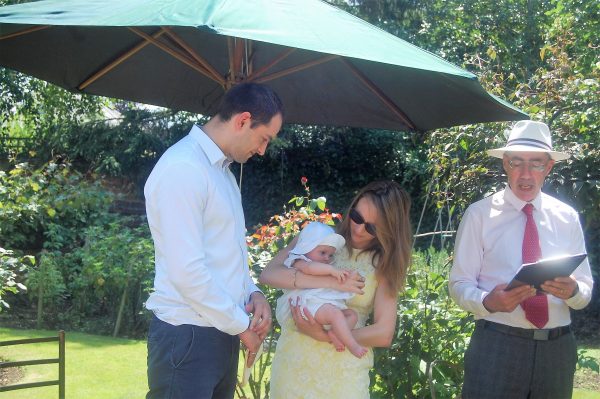
by Michael | Jan 30, 2018 | Blog
There are no guarantees about the weather anywhere. Living on an island like Britain, we are not particularly surprised by heat in winter, or rains and snow in summer. So who would dare arrange an outdoor ceremony?
A wonderful setting for a handfasting!Almost exactly four years ago, I was privileged to conduct a handfasting on an Iron Age fort that – as the picture above shows – was totally exposed. It was a period of exceptional floods across Britain. I drove down through torrential rain, and had to drive back through a thunderstorm. Amazingly, for the couple of hours I was up on Old Sarum (I had to be there early to set up), it didn’t rain and wasn’t even (very) cold.
I’ve officiated at a small number of outdoor ceremonies in the summer when the conditions were, shall we say, difficult. In one case, there was a sudden cloudburst during the wedding. Somebody had the presence of mind to bring a parasol from the hotel terrace to protect the bride (though not the celebrant!). On another occasion, a vow renewal, there was a yurt available, but the rains held off sufficiently, and we could stick to Plan A. On a third occasion, the day was cloudless and extremely hot for the naming ceremony. Fortunately, this was a garden event, and there were plenty of trees offering shade.
Sun
So what can you do, if the forecast is hot and sunny?
You can usually rely on some common sense on the part of your guests. They may bring a hat and maybe sunscreen etc.
You can make sure that plenty of cold drinks (preferably, not alcoholic at this stage) are available. Depending on the sort and size of ceremony and the venue, you may be able to offer parasols or small umbrellas for the guests. If shade is available, then make use of it. Finally, bring the guests out as late as possible, and keep the ceremony short, if that is feasible.
Wind
There’s not much you can do about wind, especially if your ceremony will be held at an exposed spot. One thing to be aware of is that wind will take sound away, so the celebrant’s voice, at least, will probably need to be amplified. Hats and veils will need attention, if they are not to be blown away.
Rain
When the rains are expected, you may be able to issue umbrellas to the guests. If there are seats, try and keep them covered with plastic, say, until the last moment.
If it’s muddy, perhaps the venue can put down some sort of (red?) carpet, so that heels don’t get submerged and trousers splashed.
Cold
Hopefully, guests will have the sense to arrive well-protected. It may be possible to issue blankets. If the length of the ceremony can be kept to a minimum, it might be appreciated by your guests.
Reality
Despite all this pessimism, of course, the chances are that the weather will be wonderful for your big day! And there’s nothing like having your ceremony outdoors – it really makes it special (just occasionally, for the wrong reasons, though!).
If your ceremony is in the grounds of the hotel, it’s worth chatting to them in advance, especially if adverse weather is anticipated. They may have a Plan B for you.
An outdoor ceremony? A gamble, yes – but one well worth taking.
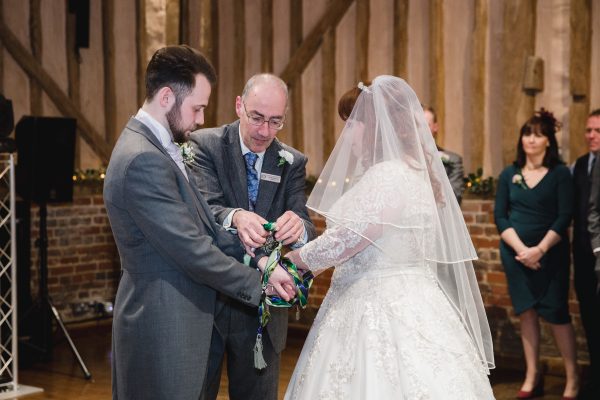
by Michael | Jan 22, 2018 | Blog
Rituals can add dramatically to the atmosphere and spirituality of a ceremony. As a civil celebrant, I am often asked for suggestions as to items that can enhance the service.
I am going to leave out religious rituals, although I do readily incorporate some, especially in mixed-faith services. For one thing, there are rather a lot of religions to mention, and I only have a few hundred words at my disposal!
There is a whole range of rituals that may appeal, so, although I’m only covering a few here, please be aware that the list is by no means exhaustive.
Moreover, there are variants to most of the rituals, so there may not be a ‘right or wrong’ way of doing them.
Handfasting
Probably my most requested ritual is handfasting. You may not know that the expression “tying the knot” is derived from this. The couple take each other’s hands, left to left and right to right. To the accompaniment of suitable words, the celebrant knots the couple’s chosen ribbons or cords (often in an infinity sign).
The couple are soon released, but take home the knotted ribbon as a reminder of what they promised each other on the day.
A handfasting can be part of a full pagan ceremony, but it may just be a brief – but beautiful and meaningful – section of the service.
Unity Rituals
The Loving Cup (or “Quaich”) is another popular inclusion. Very simply, it is a goblet (usually with some wine in – not too much!) which bride and groom both drink from, one handing the goblet to the other in turn. It symbolises unity, of course.
An alternative is a sand ceremony. This is where two (or more, to include extended family/friends) phials of sand of different colours are together poured into a bigger vial.
Similarly, you can have a Unity Candle, and two (or more) people light it with tapers.
All these actions are accompanied by appropriate words by the celebrant.
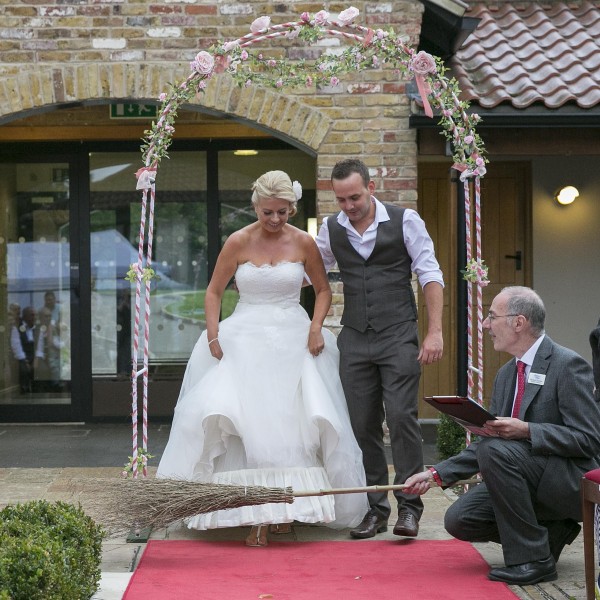
Jumping the Broom
There are various origins to this ceremony, but it involves the couple jumping over a besom (a sort of witch’s broom). The new home symbolism (sweeping out the old) is fairly evident, but it can have the extra element of introducing a bit of humour to the proceedings.
So these add-ons, or others like them, can make a real difference to the atmosphere of the ceremony.
Naturally, if you want to explore this any further, do feel free to let me know.
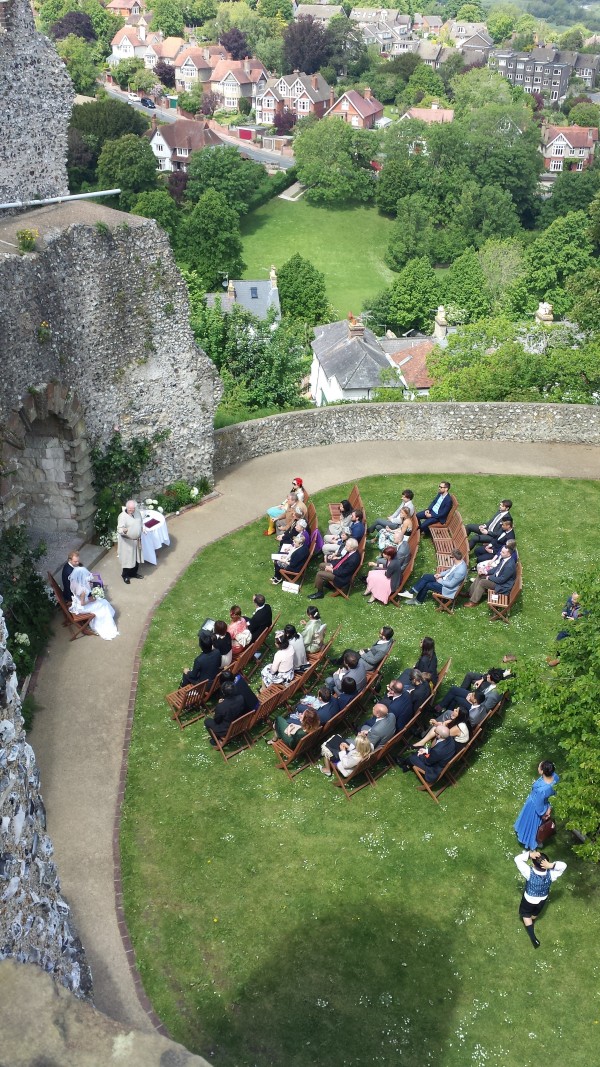
by Michael | Jan 16, 2018 | Blog
Just imagine for a moment …
What if a full religious wedding doesn’t rock your boat?
What if the secular, standard, certificate-signing at a Register Office doesn’t excite you either?
But what if you could go to the Register Office in the morning or the day before in your jeans, with a couple of witnesses?What if you signed the marriage certificate and then enjoyed a wonderful, joyous ceremony in the afternoon with all your guests?
Because you can.
With the help of a celebrant.
As long as the legal bit is still carried out, there’s nothing to stop you holding the ceremony you actually want – at the venue you want.
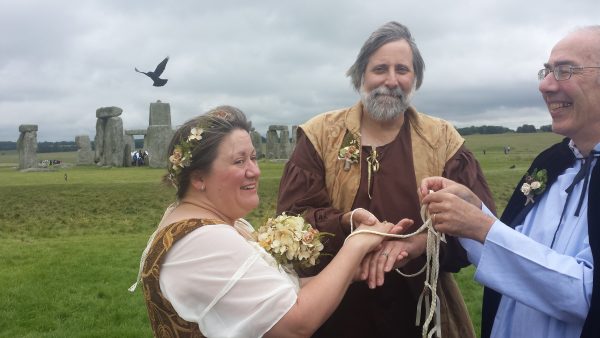
The Ceremony
One of the beauties about a celebrant-led wedding is that he or she will help you (as much or as little as you want!) to build your own ceremony. So if you want a religious component (even taken from various cultural sources), or a mixture, you can put it in; if you want spiritual elements, just go for it; poems and texts are absolutely OK. With some give and take, this way you can please yourselves AND keep your parents happy!
As well as the readings, you decide on the music. You also have the last word on the choreography (who walks or stands where), readers, the wording, and delivery, of the vows. Don’t worry, if that sounds off-putting. Your celebrant will be pleased to advise and make helpful suggestions. This process, usually conducted by e-mail, can go on over the course of several months.
Ritual
You will be able to incorporate any rituals and little touches that would not previously have been possible, if you so wish. For example, drink from a loving cup, burn a Unity Candle or have a handfasting (an ancient Celtic betrothal ritual).
Conclusion
In short, this is YOUR day, and your celebrant, who will of course conduct the ceremony for you, will do everything to ensure that the day is unforgettable, meaningful and what YOU want.
You only have to imagine (and get in touch!)!
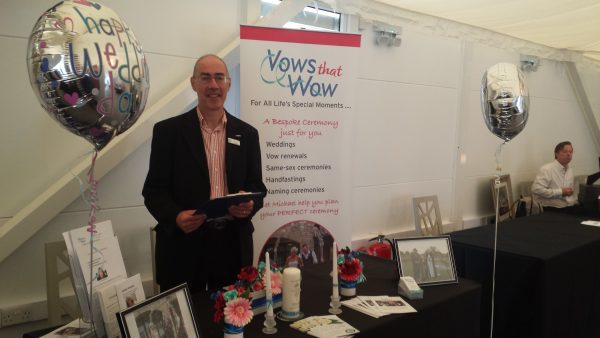
by Michael | Jan 9, 2018 | Blog
January is always a good time for decisions. They don’t just have to be resolutions to lose weight, stop smoking, go dry, or the like. They can be very big ones, like getting engaged
I often exhibit at Wedding Fayres in January, where I have the pleasure of meeting doe-eyed, often rather bewildered couples, who are floating on air after a recent engagement.

What you probably should not do
Newly-engaged couples who attend a Fayre have not necessarily come to the right place (at least, not at the right time). Of course, a Fayre offers a wide range of ideas and suppliers, but it can all prove very overpowering.
How to get started
The first thing you must do, if newly-engaged, is to sit down and choose a date (preferably, at least a year ahead, if it’s in season). You must also decide on whether the ceremony will be religious, part-religious or secular.
Then the budget will have to be settled on and you must agree what part (if any) parents are to play in the planning.
The formal bits
Next, you will need to get the bureaucracy started. If it’s a church wedding, you will need to see your vicar to arrange the banns and the actual date of the service. For any other sort of service, you will need to contact the Register Office and also arrange a celebrant. If you are marrying in a licensed premises, the registrars will come to the venue (for a price); otherwise, you go to their office by appointment.
Venue and Suppliers
Obviously, the venue will have to be booked soon, as will some suppliers like photographers. What sort of entertainment are you going to lay on? A DJ? A live group? Catering will have to be considered. Guest lists can’t be started early enough! When will you contact the florist? Are you going to have a wedding planner, perhaps? What about the clothes for the day? Make-up?
Numerous questions. … and many lead on to others. (For example, catering: do you have a cash bar? Do you offer vegan (say) options ?
Clearly, you should start planning early on, so you have time to arrange things like these.
How do you choose your supplier and venue?
Your venue search may start with the internet, but nothing can replace an actual visit. You will normally be able to meet the wedding co-ordinator, and, if you come prepared, you can ask plenty of questions. Most importantly, you will get a feel for the atmosphere of the venue, and that is so important.
Suppliers (and possibly venues) are best chosen by word-of-mouth. If somebody has worked with them already, they will be able to vouch for the supplier’s professionalism, ability and pleasantness.
If you can’t find a recommendation, testimonials on the website will give a clue (though not much more than that, necessarily). It is best to have a chat on the phone or, better, face-to-face, and you may have a feel for whether they are going to be right for you.
Come what may, you have embarked on an incredibly exciting – though potentially challenging – journey. Buckle your seat-belt on and love the ride!








